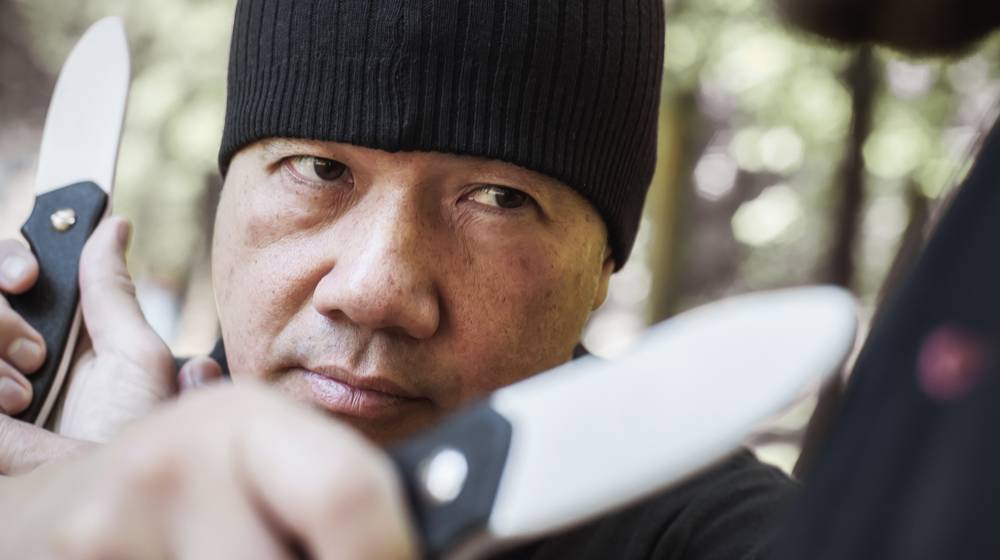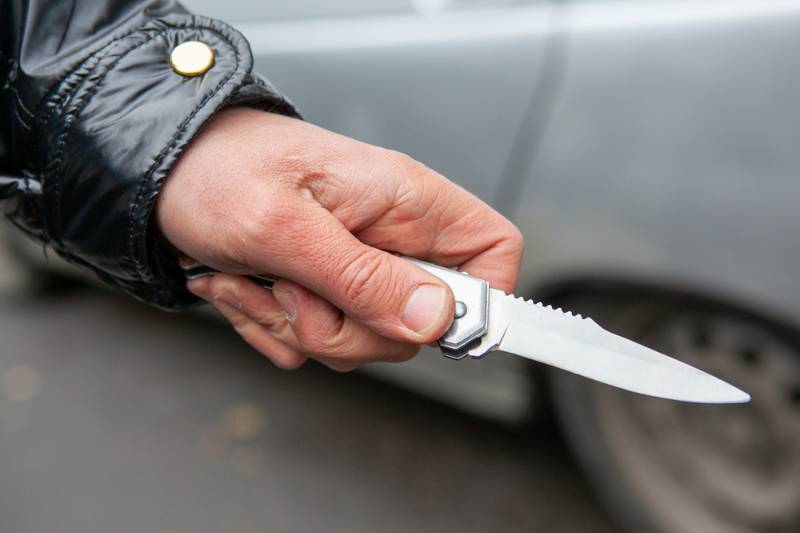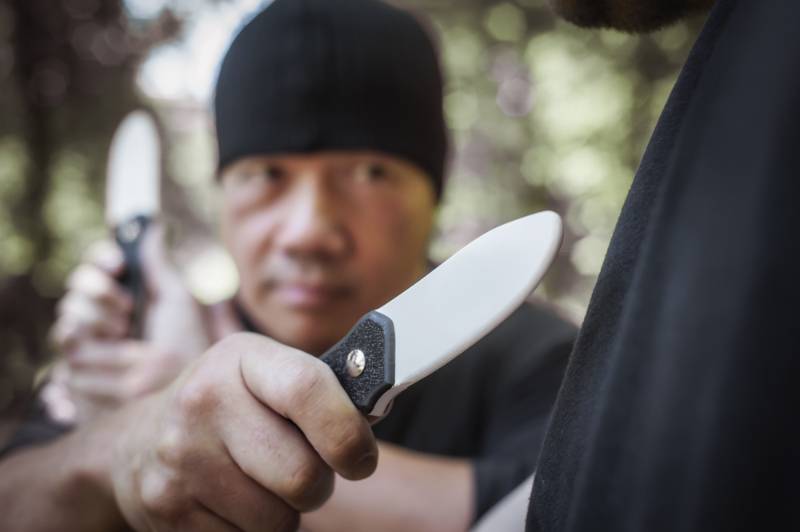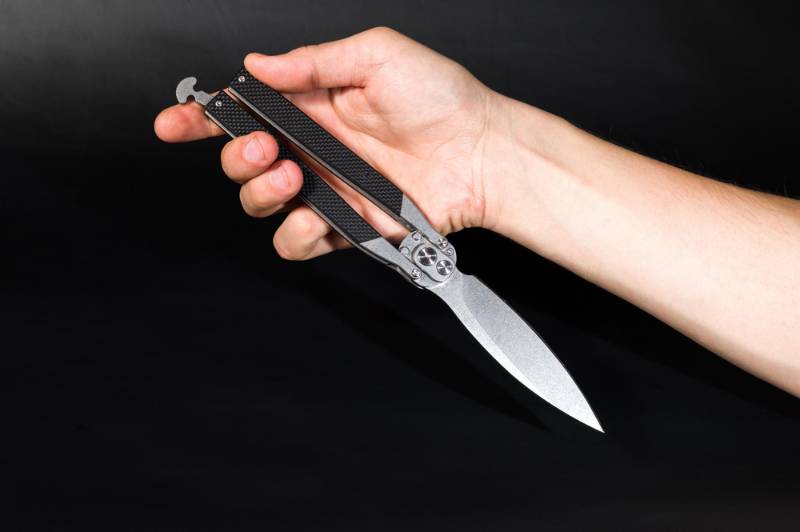Survival Skills
13 Knife Fighting Techniques And Tips From A Filipino Knife Fighter
Published
4 years agoon

[Editors Note] A friend of mine over in Manila who is an avid practicer of using knives as a weapon wrote this article and asked me if I’d share these knife fighting techniques and tips with our community (Keep in mind that these aren’t my views and I am definitely not a trained knife fighter). It’s definitely got some interesting points and I thought you guys and gals might enjoy it.
I’ve been practicing knife fighting for over a year now. While my dreams of being a professional knife fighter like The Winter Soldier have crumbled away, it has brought me some serious and lethal realizations about using knives for combat and survival.
RELATED: 10 Folding Hunting Knives For The Outdoor Warrior | Hunter Gear
13 Knife Fighting Techniques And Tips from an Expert
— This post is courtesy of the American Gun Association shared with permission —
1. The Knife is Lethal

Once you’ve become involved in an altercation that has caused you to expose your knife, you need to remember that you are holding a lethal weapon. There is no other way to use a knife in a fight than to strike with fierce lethality. If you intend to use it simply to scare an opponent, you are an idiot.
Once a skilled opponent has seen you pull out your survival knife, the first thing he does is study the length and build of the stainless steel. Then he will strategize how to kill you.
Tip: Don’t give your opponent that chance. Pull out your knife only when you’re in a position to lethally strike your opponent.
2. It’s ‘Always On’

Strictly speaking, there is no ‘on and off’ button with a knife. Sure, you can argue that an automatic folding knife has a safety lock, but once the blade is out, it’s out. There’s no reloading time, there’s no concept of ammunition with a knife. It’s a weapon always ready to draw blood.
Tip: Bring a knife that is easy to deploy in times-of-need. A folding knife is great, but a fixed blade is even better. Make sure you carry it in such a way that it’s easy to pull out if you’re carrying it inside waistband (IWB) style.
3. The Biggest Myth About a Knife Fight…

Knife disarming techniques are deadly self-defense moves – for the one doing the disarming. We regularly spar with dull wooden blades here and 100% of the time, disarms don’t work.
If you are about to try to lock the hand or arm of an attacker, you can expect to get stabbed 5 – 10 times before actually being able to do so. On top of that, the only reason you are able to lock your opponent’s hand or arm is your opponent’s fatigue. If your opponent is in good condition, you will never disarm your opponent through locks.
Tip: Hitting your attacker’s face with a blunt weapon, a head-butt, your fist, or your palm for disorientation is a much better way to approach a disarm for self-defense training. Even so, prepare to get stabbed before being able to disarm your opponent.
4. The 21′ Rule

If you are educated in the way of the knife, you have a 21 feet allowance from anyone wielding a gun to be able to close the gap and turn the fight into hand-to-hand combat.
Tip: The trick is to keep your eyes open and avoid staring only at the gun. Always be alert to your surroundings.
5. Don’t Overestimate Your Knife

I’ve had some realistic medium training in the past with another knife fighter. I found there were times when my knife would not cut the flesh deep enough or would not puncture the flesh easily enough.
During those sobering moments, I realized it was hard enough to stab, puncture, and cut where you want to. It was even harder to make sure the damage is deep enough.
Tip: Always make sure the knife is razor sharp with knife sharpeners. A dull knife can set you up for missed opportunities in damaging or critically wounding your opponent. Keep both your knife and sheath in good condition.
6. Cuts Are Overrated

While slashing moves are instinctive and natural for us – especially for those who aren’t so used to wielding a knife for combat, it’s the stabbing that does the real damage. Slitting someone’s throat records a higher survival rate than we are set to believe. That’s because, no matter how good your grip or strike is, usually the damage is not deep enough.
Tip: Stabbing someone in the femoral artery, brachial area, neck, lungs, groin, or anus, however, ensures death for your opponent. Plus, it’s easier to stab someone than to cut someone deep enough to kill.
7. Human Anatomy Is the Key to Victory

TIME SENSITIVE INFORMATION: EX-CIA Agent Takes You Through The Intensive Sharp Shooter Training He Learned In The CIA Academy. In Just 30 Days Learn To Be A Sharp Shooter Like Every Agent Leaving The Academy.
There are only a handful of places where you can stab someone and make sure the person ends up dead or permanently incapacitated. The brain stem and other areas I mentioned in the previous tip is a good example. The femoral artery, for one, ensures immediate excessive bleeding.
Stabbing someone in the stomach can mean a long way off from death and he or she has a high chance of stabbing you back.
Tip: Better to strike with your weapon once and strike lethally than to do ten stabs in non-critical areas and risk the person fighting back and wounding you.
RELATED: This Non-Lethal Self Defense Pistol Is The Best Thing We’ve Seen
8. Hitting Them Between the Eyes Is Almost Never an Option

That said, the eyes are extremely hard to hit. Even if hitting the eyes can immediately end the fight, it’s not worth the risk of getting yourself stabbed. Human beings have the ultimate instinct to defend the eyes ferociously from any weapon.
Tip: If you can make your opponent blink by faking an eye attack, that is a thousand times better than actually trying to hit the eyes.
9. Deception Is Everything

But you can only use it once. In my opinion, the best way to use deception is to try to make an exit. Whether you drop lines about not knowing the problem, not knowing the person, or not wanting to fight – use whatever means necessary for you to get out of the situation.
Tip: Some people even go so far as to say they are blood-related in some way with the opponent. While it may sound funny, in a dire situation, it may just give you a few critical seconds to land a lethal blow or to run away.
10. You’re Going to Get Cut…Deal with It

The sooner you accept this fact, the better you’ll get at improving your knife fighter skills. There is almost no way for you to walk away from a knife fight without a scratch.
If you condition yourself to take in the damage, the more you will be able to handle it. That said, make sure you have the skills and ability to manage and treat your wounds immediately after a fight.
Tip: Learn about wound management even as you’re learning about knife fighting.
11. The Best Fight Is the One You Avoid

Only fight when you really have to. When that situation is, you have to be discerning enough to know. If you ask me, if you’re being held up for valuables or possessions, just give it up.
It’s not worth risking a stab in the kidney or gut for. But if your life or a family member is threatened, it’s high time to pull out that knife and act quickly.
Tip: Run. Running away is the best thing to do in most unfortunate situations. Condition your body in such a way you can run fast, run quickly, and run for miles.
12. Always Carry a Knife…Always

Considering everything I mentioned here, always bring a knife – whether it’s for work, utility, or self-defense. A knife is a useful tool to always bring with you.
As to how many you prefer to bring, that’s up to you. Make sure you comply with the laws of your state or country in terms of knife carry length, style, etc.
Tip: Make sure your knives are well-maintained, preferably oiled, razor-sharp, and always ready to pull out in times of need.
13. Myth: Taking a Cut Is Okay

Unless you are wearing an iron man suit, never ever try to take a cut – even one cut – with your arm. Once you do that, your chances of winning a fight essentially drop to zero.
No one can grip properly and fight with blood gushing out from a cut or a chunk of flesh dangling from their arm. Once you think of taking a cut with your arm, the fight is essentially over.
Tip: Put a lot of practice and thought into your footwork. If you grip the knife on your right, your right foot should always be forward. Know how to dodge and check the knife hand of your opponent.
Want to see the full article?
Click here to read the full article on American Gun Association.
Knives are not self-defense weapons like tasers or a bayonet. A fight with a knife fighter is also not the same in martial arts like Brazilian jiu-jitsu and taekwondo.
Knives are lethal weapons that can fatally wound you or be the key to your survival. Be a better knife fighter with these tips 13 brutal in mind!
Are you a trained knife fighter? Do have any vital knife fighting techniques to share? Let us know in the comments below.
Up Next:
- Quest For The Best Hunting Knife | Three Of The Best Hunting Knives In The World
- Nelson’s Guide To A Complete Hog Hunting Gear
- The Art Of Choosing The Best Archery Equipment | Outdoor Warrior
Don’t forget to stay connected with us on Facebook, Twitter, Pinterest, and Instagram!
Disclaimer: All content on this site is for informational purposes only. Please read our full disclaimer here.
You may like

How To Build A Debris Hut

Ironman Triathlon Podcast: What You Need To Know As An Aspiring Ironman

Awesome Family Camping Tips For Beginners

Hiking Safety Tips: What To Do When You Have Knee Pain On Trail? [PODCAST]

How To Craft Sharp Stone Tools To Survive The Great Outdoors

Mountain Bikers, Why You Don’t Want to Ride Like a Pro!

Hiking Boot Accessories
The Handgun Safety Test For Beginners
These Hunting Shotguns Are The Best Bang For Your Buck
11 Types of Guns That Will Keep You Alive On Doomsday
Best ATV Tires – The Top 6 Lightest Mud Tires
Arizona Hunting Laws and Regulations

The Top 5 Hunting Guns You’ll Ever Need For A Wilderness Walk-out

Hunting And Conservation Discussion | Call Of The Outdoors Podcast [LISTEN]
The Handgun Safety Test For Beginners
These Hunting Shotguns Are The Best Bang For Your Buck
11 Types of Guns That Will Keep You Alive On Doomsday
Best ATV Tires – The Top 6 Lightest Mud Tires
Arizona Hunting Laws and Regulations

The Top 5 Hunting Guns You’ll Ever Need For A Wilderness Walk-out






